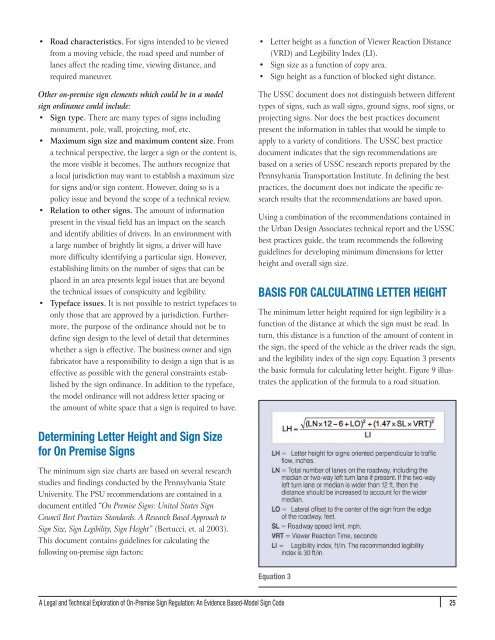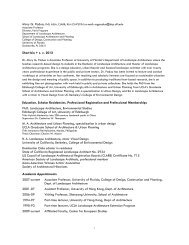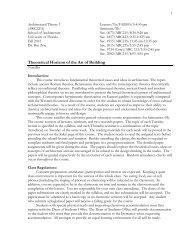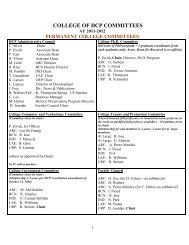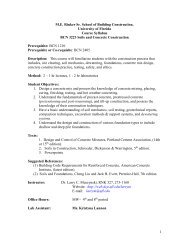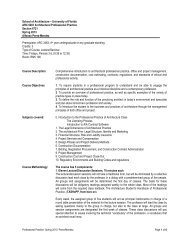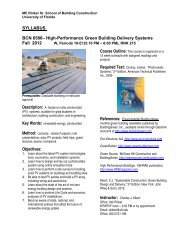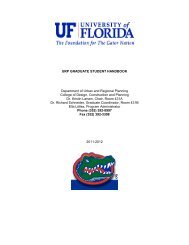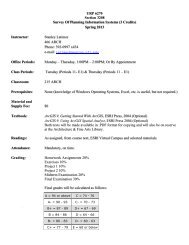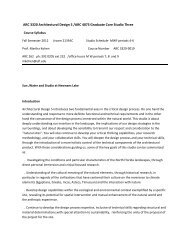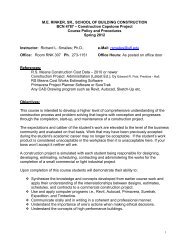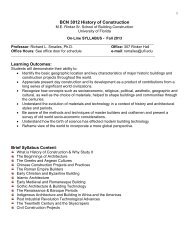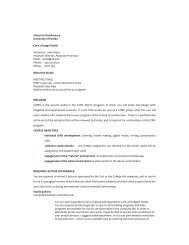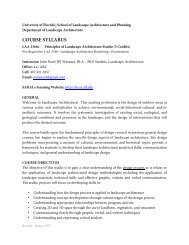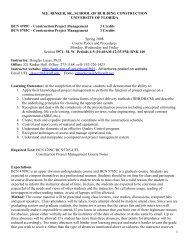An Evidence Based Model Sign Code - College of Design ...
An Evidence Based Model Sign Code - College of Design ...
An Evidence Based Model Sign Code - College of Design ...
Create successful ePaper yourself
Turn your PDF publications into a flip-book with our unique Google optimized e-Paper software.
• Road characteristics. For signs intended to be viewed<br />
from a moving vehicle, the road speed and number <strong>of</strong><br />
lanes affect the reading time, viewing distance, and<br />
required maneuver.<br />
Other on-premise sign elements which could be in a model<br />
sign ordinance could include:<br />
• <strong>Sign</strong> type. There are many types <strong>of</strong> signs including<br />
monument, pole, wall, projecting, ro<strong>of</strong>, etc.<br />
• Maximum sign size and maximum content size. From<br />
a technical perspective, the larger a sign or the content is,<br />
the more visible it becomes. The authors recognize that<br />
a local jurisdiction may want to establish a maximum size<br />
for signs and/or sign content. However, doing so is a<br />
policy issue and beyond the scope <strong>of</strong> a technical review.<br />
• Relation to other signs. The amount <strong>of</strong> information<br />
present in the visual field has an impact on the search<br />
and identify abilities <strong>of</strong> drivers. In an environment with<br />
a large number <strong>of</strong> brightly lit signs, a driver will have<br />
more difficulty identifying a particular sign. However,<br />
establishing limits on the number <strong>of</strong> signs that can be<br />
placed in an area presents legal issues that are beyond<br />
the technical issues <strong>of</strong> conspicuity and legibility.<br />
• Typeface issues. It is not possible to restrict typefaces to<br />
only those that are approved by a jurisdiction. Furthermore,<br />
the purpose <strong>of</strong> the ordinance should not be to<br />
define sign design to the level <strong>of</strong> detail that determines<br />
whether a sign is effective. The business owner and sign<br />
fabricator have a responsibility to design a sign that is as<br />
effective as possible with the general constraints established<br />
by the sign ordinance. In addition to the typeface,<br />
the model ordinance will not address letter spacing or<br />
the amount <strong>of</strong> white space that a sign is required to have.<br />
• Letter height as a function <strong>of</strong> Viewer Reaction Distance<br />
(VRD) and Legibility Index (LI).<br />
• <strong>Sign</strong> size as a function <strong>of</strong> copy area.<br />
• <strong>Sign</strong> height as a function <strong>of</strong> blocked sight distance.<br />
The USSC document does not distinguish between different<br />
types <strong>of</strong> signs, such as wall signs, ground signs, ro<strong>of</strong> signs, or<br />
projecting signs. Nor does the best practices document<br />
present the information in tables that would be simple to<br />
apply to a variety <strong>of</strong> conditions. The USSC best practice<br />
document indicates that the sign recommendations are<br />
based on a series <strong>of</strong> USSC research reports prepared by the<br />
Pennsylvania Transportation Institute. In defining the best<br />
practices, the document does not indicate the specific research<br />
results that the recommendations are based upon.<br />
Using a combination <strong>of</strong> the recommendations contained in<br />
the Urban <strong>Design</strong> Associates technical report and the USSC<br />
best practices guide, the team recommends the following<br />
guidelines for developing minimum dimensions for letter<br />
height and overall sign size.<br />
BASIS FOR CALCULATING LETTER HEIGHT<br />
The minimum letter height required for sign legibility is a<br />
function <strong>of</strong> the distance at which the sign must be read. In<br />
turn, this distance is a function <strong>of</strong> the amount <strong>of</strong> content in<br />
the sign, the speed <strong>of</strong> the vehicle as the driver reads the sign,<br />
and the legibility index <strong>of</strong> the sign copy. Equation 3 presents<br />
the basic formula for calculating letter height. Figure 9 illustrates<br />
the application <strong>of</strong> the formula to a road situation.<br />
Determining Letter Height and <strong>Sign</strong> Size<br />
for On Premise <strong>Sign</strong>s<br />
The minimum sign size charts are based on several research<br />
studies and findings conducted by the Pennsylvania State<br />
University. The PSU recommendations are contained in a<br />
document entitled “On Premise <strong>Sign</strong>s: United States <strong>Sign</strong><br />
Council Best Practices Standards. A Research <strong>Based</strong> Approach to<br />
<strong>Sign</strong> Size, <strong>Sign</strong> Legibility, <strong>Sign</strong> Height” (Bertucci, et. al 2003).<br />
This document contains guidelines for calculating the<br />
following on-premise sign factors:<br />
Equation 3<br />
A Legal and Technical Exploration <strong>of</strong> On-Premise <strong>Sign</strong> Regulation: <strong>An</strong> <strong>Evidence</strong> <strong>Based</strong>-<strong>Model</strong> <strong>Sign</strong> <strong>Code</strong> 25


